Integrated Energy Systems Modeling with Multi-Criteria Decision Analysis and Stakeholder Engagement for Identifying a Sustainable Energy Transition
Abstract
1. Introduction
2. Literature Review
3. Methods
3.1. Key Components of the Integrated Framework
3.1.1. Sustainability Themes and Indicators
3.1.2. Dynamic Energy Systems Modeling
- Fleet mix;
- Fuel demand and the share of indigenous renewable resources;
- GHG emissions reduction (well-to-tank, tank-to-wheel, and well-to-wheel emissions);
- Electricity supply capacity and generation cost;
- Consumer costs (fuel use cost, vehicle usage cost, and vehicle capital cost);
- Government tax revenue.
3.1.3. MCDA Framework
- Identify the sustainability themes;
- Create the decision matrix, where each element represents the performance of a policy bundle in each theme;
- Normalize the decision matrix (Four normalization methods have been studied: vector normalization, linear scale transformation (Max–Min) linear scale transformation (Max), and linear scale transformation (Sum));
- Define the ideal and negative ideal solutions;
- Estimate the weighted Euclidean distances from ideal and negative ideal solutions;
- Rank the alternatives based on the performance index (relative closeness to the ideal solution).
3.1.4. Integrated Framework
3.2. Scenario Development
- Baseline: following recent trend: GDP growth: 2.5% until 2030 and 2% after 2030;
- Slow GDP growth: 1% growth until 2030 and 1.5% after 2030;
- High GDP growth driven by tourism: 3% growth until 2030 and 2.5% after 2030.
- Baseline, based on historical trends in changes in energy efficiency (constant efficiency);
- Alternative high-efficiency pathway, where the fuel economy of new vehicles will improve by 20% by 2050 for all vehicle types, and the industrial sector, which will see an average efficiency improvement of 1.5% per year (high efficiency).
- Baseline bundle, based on the assumption that current regulations on vehicle and fuel taxes will remain unchanged until 2050 [66];
- Premium policy bundle incorporating enhanced incentives in terms of continued VAT exemptions for the purchase price of BEVs within both light and heavy vehicle fleets for the duration of the simulation period [66];
- Banning policy bundle, in which the proposed tax scheme is evaluated under a banning condition for the new registration of ICEs and HEVs (with petrol or diesel fuels) from 2025 and, therefore, only the registration of PHEVs and BEVs will be allowed after 2025. Such a banning regulation is part of the Icelandic Government’s Climate Action Plan, albeit set at a later date [67,68].
- G__: BAU GDP Growth 2.5% until 2025, 2% until 2050
- S__: Slow GDP growth 1% until 2025, 1.5% until 2050
- T__: High tourism led GDP growth 3% until 2025, 2.5% until 2050
- _A_: BAU constant energy efficiency based on current trends
- _B_: Max improvements in energy efficiency
- __C: BAU Current fuel and vehicle tax
- __N: New tax proposals on fuel and vehicles
- __X: New tax proposals and ban on ICE/HEV from 2025
4. Results
4.1. Sustainablity Themes, Subthemes, and Indiators
4.2. Energy Systems Development
4.3. Comparing Sustainability Impacts
4.4. MCDA Results
5. Discussion
6. Conclusions
Author Contributions
Funding
Data Availability Statement
Conflicts of Interest
Appendix A
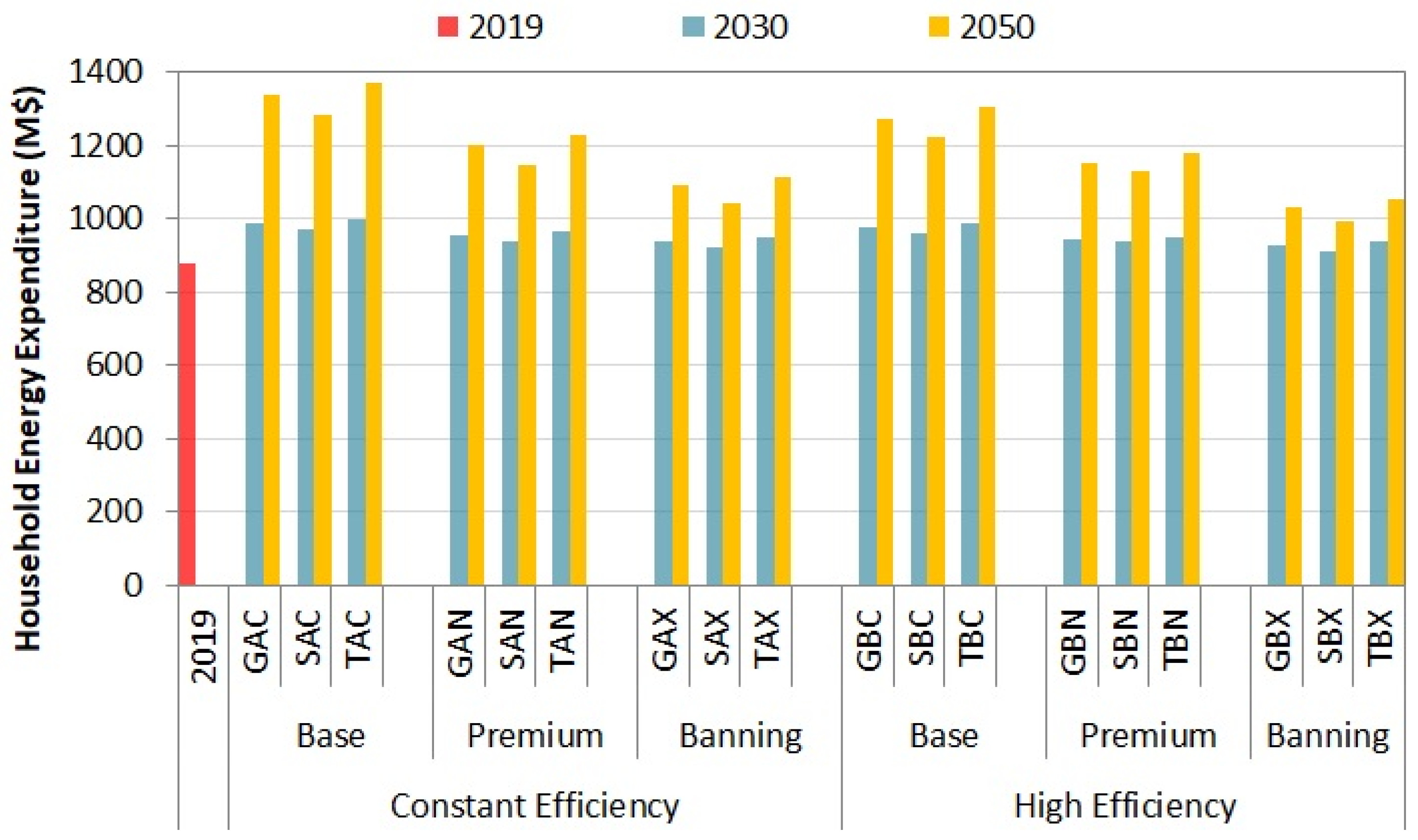
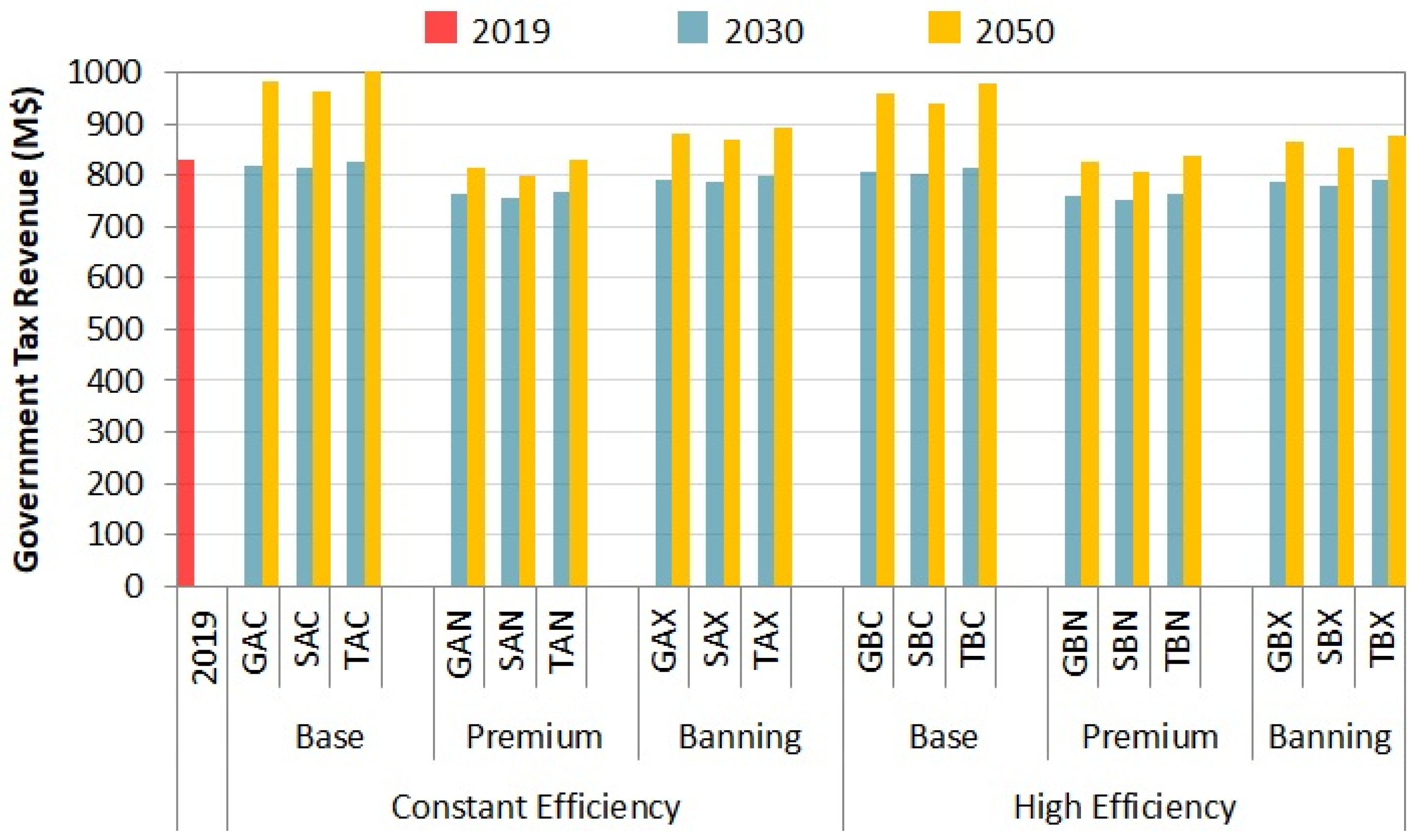
Appendix B
| Norm 1: Vector Normalization | Norm 2: Linear Scale Transformation | Norm 3: Linear Scale Transformation | Norm 4: Linear Scale Transformation | |
|---|---|---|---|---|
| GAC | 0.26 | 0.13 | 0.97 | 0.11 |
| SAC | 0.26 | 0.31 | 0.98 | 0.33 |
| TAC | 0.29 | 0.15 | 0.97 | 0.13 |
| GAN | 0.41 | 0.27 | 0.00 | 0.24 |
| SAN | 0.43 | 0.47 | 0.98 | 0.47 |
| TAN | 0.44 | 0.28 | 0.97 | 0.25 |
| GAX | 0.62 | 0.43 | 0.98 | 0.39 |
| SAX | 0.65 | 0.62 | 0.99 | 0.61 |
| TAX | 0.64 | 0.43 | 0.98 | 0.39 |
| GBC | 0.39 | 0.43 | 0.98 | 0.44 |
| SBC | 0.40 | 0.59 | 0.99 | 0.63 |
| TBC | 0.39 | 0.40 | 0.98 | 0.41 |
| GBN | 0.57 | 0.58 | 0.98 | 0.58 |
| SBN | 0.54 | 0.72 | 0.99 | 0.74 |
| TBN | 0.57 | 0.56 | 0.98 | 0.56 |
| GBX | 0.84 | 0.76 | 0.99 | 0.74 |
| SBX | 0.74 | 0.87 | 1.00 | 0.89 |
| TBX | 0.83 | 0.74 | 0.99 | 0.72 |
Appendix C
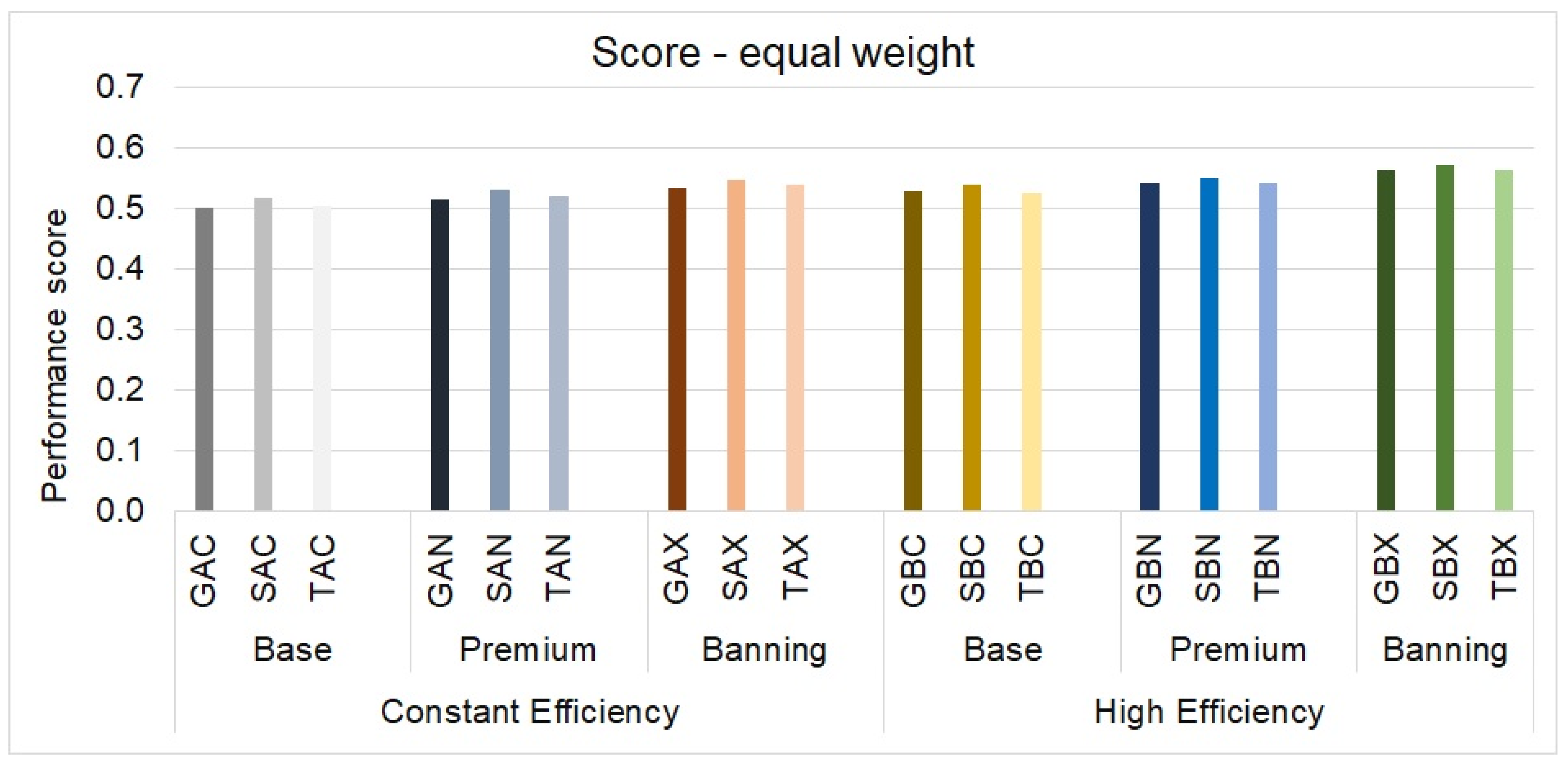
Appendix D
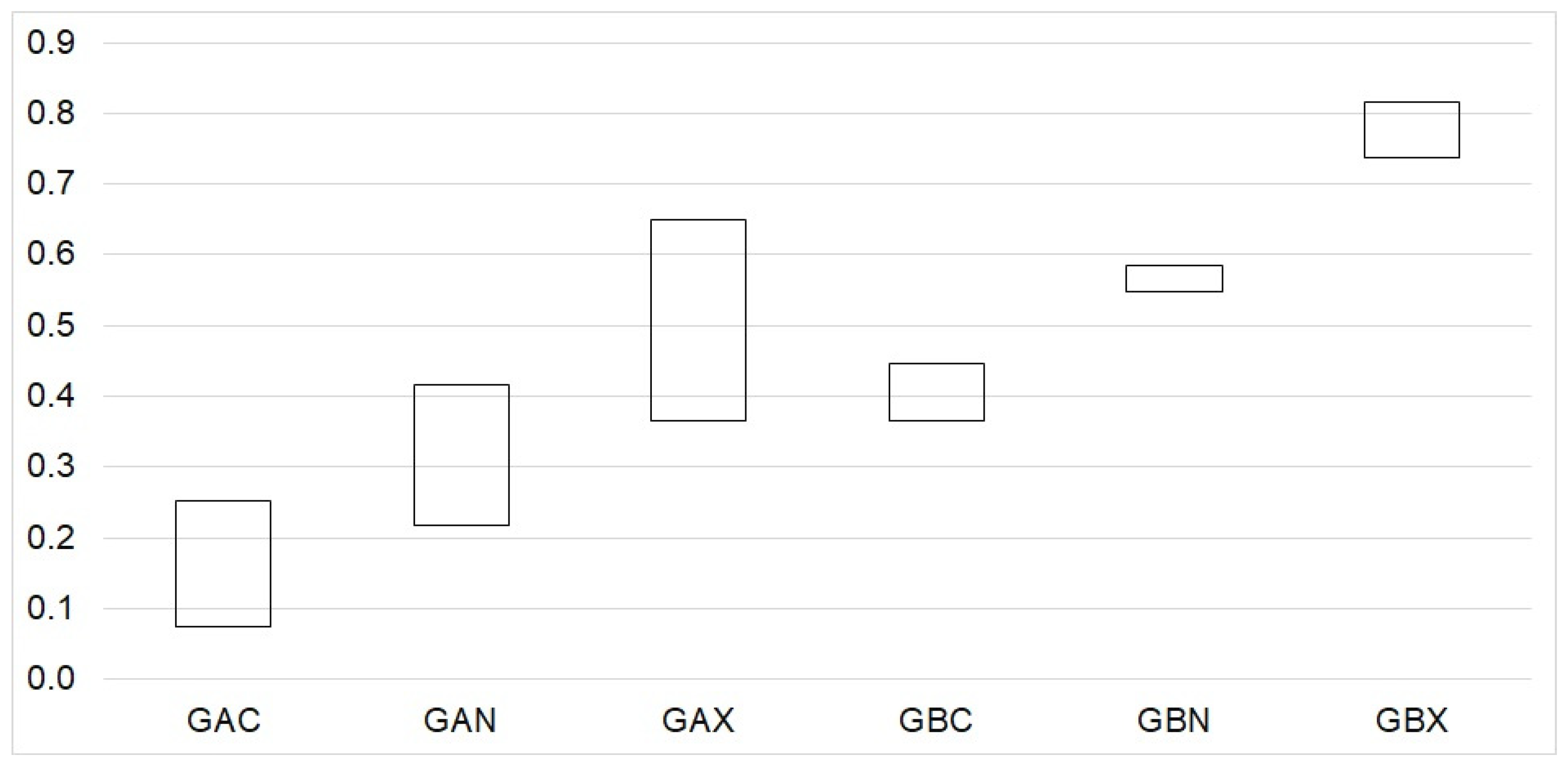
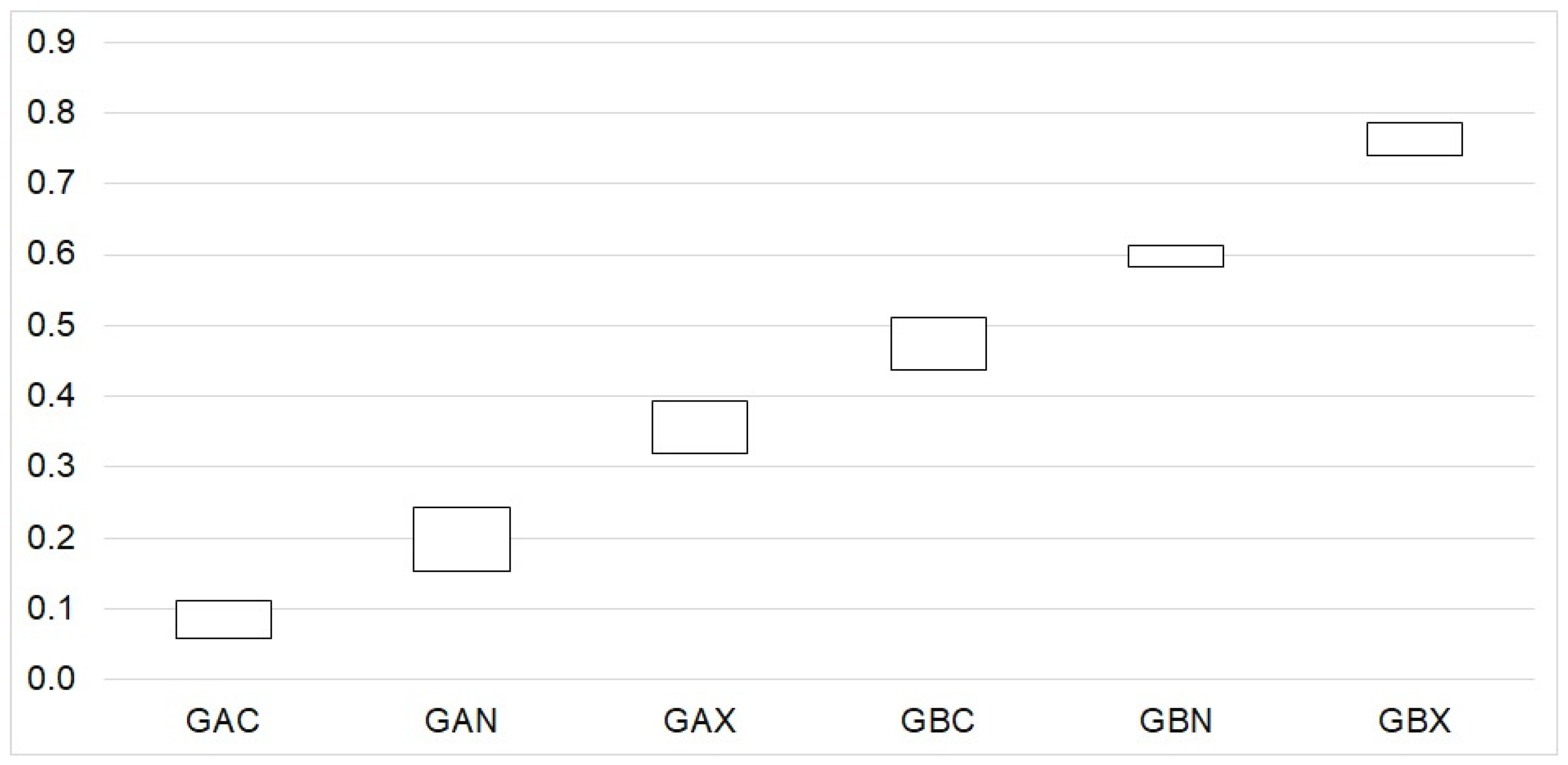
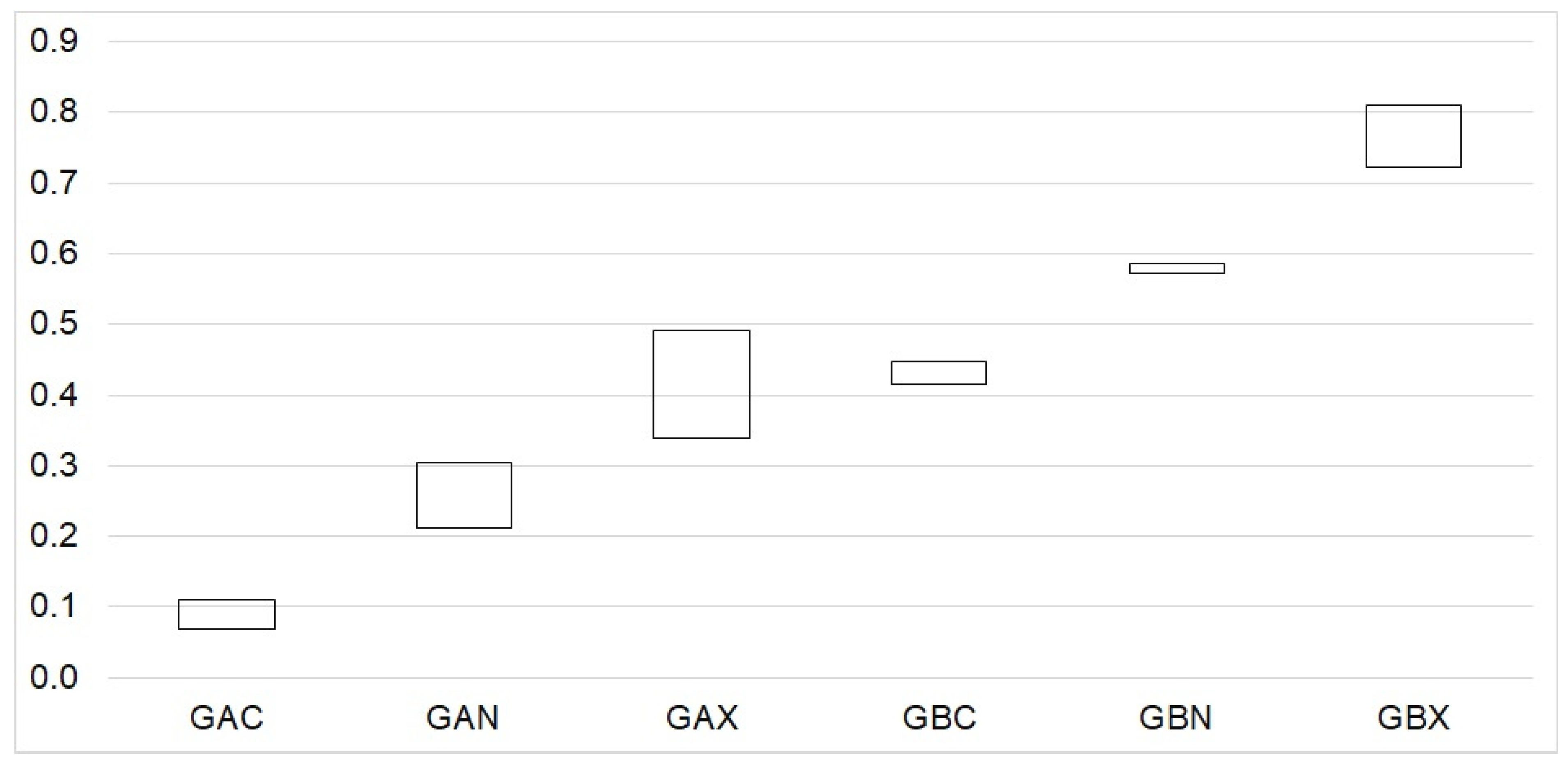
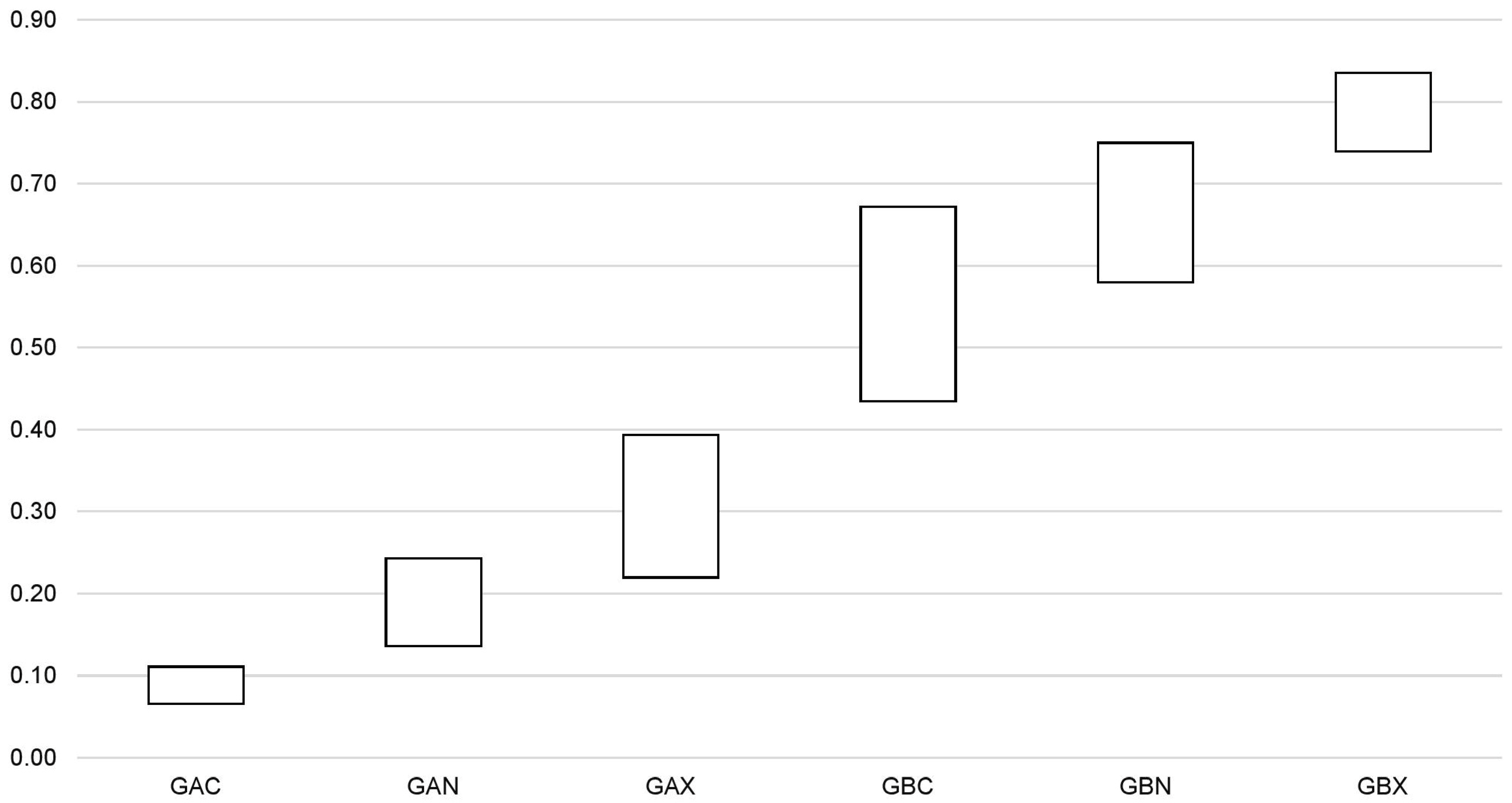

References
- United Framework Convention on Climate Change; Paris Agreement, United Nations Framework Convention on Climate Change: Paris, France, 2015.
- IPCC. Climate Change 2023: Synthesis Report. In Contribution of Working Groups I, II and III to the Sixth Assessment Report of the Intergovernmental Panel on Climate Change; Lee, H., Romero, J., Eds.; IPCC: Geneva, Switzerland, 2023; p. 184. [Google Scholar] [CrossRef]
- United Nations Environment Programme. Emissions Gap Report 2023: Broken Record—Temperatures Hit New Highs, Yet World Fails to Cut Emissions (Again); UNEP: Nairobi, Kenya, 2023; p. 80. [Google Scholar] [CrossRef]
- Rogelj, J.; Luderer, G.; Pietzcker, R.C.; Kriegler, E.; Schaeffer, M.; Krey, V.; Riahi, K. Energy system transformations for limiting end-of-century warming to below 1.5 °C. Nat. Clim. Chang. 2015, 5, 519–527. [Google Scholar] [CrossRef]
- International Atomic Energy Agency and International Energy Agency (IAEA/IEA). Indicators for Sustainable Energy Development: Report presented at the Ninth Session of the Commission on Sustainable Development; IAEA/IEA: New York, NY, USA, 2001; p. 5. [Google Scholar]
- Nerini, F.; Hughes, N.; Cozzi, L.; Cosgrave, E.; Howells, M.; Tavoni, M.; Tomei, J.; Zerriffi, H.; Milligan, B. Shore up support for climate action using SDGs. Nature 2018, 557, 31. [Google Scholar] [CrossRef]
- Brutschin, E.; Pianta, S.; Tavoni, M.; Riahi, K.; Bosetti, V.; Marangoni, G.; van Ruijven, B.J. A multidimensional feasibility evaluation of low-carbon scenarios. Environ. Res. Lett. 2021, 16, 064069. [Google Scholar] [CrossRef]
- Akpan, J.; Olanrewaju, O. Sustainable Energy Development: History and Recent Advances. Energies 2023, 16, 7049. [Google Scholar] [CrossRef]
- World Bank and International Energy Agency. Sustainable Energy for All 2015: Progress toward Sustainable Energy; World Bank: Washington, DC, USA, 2015; p. 80. [Google Scholar]
- Gladkykh, G.; Spittler, N.; Diemer, A. Energy Modelling for Reaching SDG7. In Affordable and Clean Energy; Filho, W.L., Azul, A.M., Brandli, L., Salvia, A.L., Wall, T., Eds.; Springer Nature: Cham, Switzerland, 2021; pp. 448–459. [Google Scholar] [CrossRef]
- Wang, J.; Chen, H.; Cao, Y.; Wang, C.; Li, J. An integrated optimization framework for regional energy planning with a sustainability assessment model. Sustain. Prod. Consum. 2023, 36, 526–539. [Google Scholar] [CrossRef]
- Gunnarsdottir, I.; Davidsdottir, B.; Worrell, E.; Sigurgeirsdottir, S. Review of indicators for sustainable energy development. Renew. Sustain. Energy Rev. 2020, 133, 110294. [Google Scholar] [CrossRef]
- Narula, K.; Reddy, B.S. Three blind men and an elephant: The case of energy indices to measure energy security and energy sustainability. Energy 2015, 80, 148–158. [Google Scholar] [CrossRef]
- Gunnarsdóttir, I.; Davíðsdóttir, B.; Worrell, E.; Sigurgeirsdottir, S. It is best to ask: Designing a stakeholder-centric approach to selecting sustainable energy development indicators. Energy Res. Soc. Sci. 2021, 74, 101968. [Google Scholar] [CrossRef]
- Loftus, P.J.; Cohen, A.M.; Long, J.C.S.; Jenkins, J.D. A critical review of global decarbonization scenarios: What do they tell us about feasibility? A critical review of global decarbonization scenarios. Wiley Interdiscip. Rev. Clim. Chang. 2014, 6, 93–112. [Google Scholar] [CrossRef]
- Diemer, A.; Gladkykh, G.; Spittler, N.; Collste, D.; Ndiaye, A.; Dierickx, F. Integrated Assessment Models (IAM) How to integrate Economics, Energy and Climate? In Integrated Assessment Models and Other Climate Policy Tools; Diemer, A., Gladkykh, G., Spittler, N., Collste, D., Ndiaye, A., Dierickx, F., Eds.; Oeconomia: Paris, France, 2019; pp. 20–48. [Google Scholar]
- van Soest, H.L.; van Vuuren, D.P.; Hilaire, J.; Minx, J.C.; Harmsen, M.J.; Krey, V.; Popp, A.; Riahi, K.; Luderer, G. Analysing interactions among Sustainable Development Goals with Integrated Assessment Models. Glob. Transit. 2019, 1, 210–225. [Google Scholar] [CrossRef]
- Moreno, J.; Campagnolo, L.; Boitier, B.; Nikas, A.; Koasidis, K.; Gambhir, A.; Gonzalez-Eguino, M.; Perdana, S.; Van de Ven, D.-J.; Chiodi, A.; et al. The impacts of decarbonization pathways on Sustainable Development Goals in the European Union. Commun. Earth Environ. 2024, 5, 136. [Google Scholar] [CrossRef]
- Keyßer, L.T.; Lenzen, M. 1.5 °C degrowth scenarios suggest the need for new mitigation pathways. Nat. Commun. 2021, 12, 2676. [Google Scholar] [CrossRef] [PubMed]
- Capros, P.; Tasios, N.; De Vita, A.; Mantzos, L.; Paroussos, L. Model-based analysis of decarbonising the EU economy in the time horizon to 2050. Energy Strat. Rev. 2012, 1, 76–84. [Google Scholar] [CrossRef]
- Siskos, P.; Zazias, G.; Petropoulos, A.; Evangelopoulou, S.; Capros, P. Implications of delaying transport decarbonisation in the EU: A systems analysis using the PRIMES model. Energy Policy 2018, 121, 48–60. [Google Scholar] [CrossRef]
- Gardumi, F.; Keppo, I.; Howells, M.; Pye, S.; Avgerinopoulos, G.; Lekavičius, V.; Galinis, A.; Martišauskas, L.; Fahl, U.; Korkmaz, P.; et al. Carrying out a multi-model integrated assessment of European energy transition pathways: Challenges and benefits. Energy 2022, 258, 124329. [Google Scholar] [CrossRef]
- Korkmaz, P.; Montenegro, R.C.; Schmid, D.; Blesl, M.; Fahl, U. On the Way to a Sustainable European Energy System: Setting Up an Integrated Assessment Toolbox with TIMES PanEU as the Key Component. Energies 2020, 13, 707. [Google Scholar] [CrossRef]
- Sverdrup, H.; Koca, D. The WORLD Model Development and the Integrated Assessment of the Global Natural Resources Supply; FKZ 3712 93 102; Umweltbundesamt: Berlin, Germany, 2018; p. 444. Available online: https://www.umweltbundesamt.de/publikationen/the-world-model-development-the-integrated (accessed on 20 May 2024).
- Randers, J.; Rockström, J.; Stoknes, P.-E.; Goluke, U.; Collste, D.; Cornell, S.E.; Donges, J. Achieving the 17 Sustainable Development Goals within 9 planetary boundaries. Glob. Sustain. 2019, 2, e24. [Google Scholar] [CrossRef]
- Qu, W.; Barney, G.O.; Symalla, D.; Martin, L. The Threshold 21: National Sustainable Development Model. In Integrated Global Models of Sustainable Development—Volume 2; Onishi, A., Ed.; UNESCO-EOLSS: Paris, France, 2002; p. 235. [Google Scholar]
- Collste, D.; Cornell, S.E.; Randers, J.; Rockström, J.; Stoknes, P.E. Human well-being in the Anthropocene: Limits to growth. Glob. Sustain. 2021, 4, e30. [Google Scholar] [CrossRef]
- Collste, D.; Pedercini, M.; Cornell, S.E. Policy coherence to achieve the SDGs: Using integrated simulation models to assess effective policies. Sustain. Sci. 2017, 12, 921–931. [Google Scholar] [CrossRef]
- Sverdrup, H.U.; Olafsdottir, A.H.; Ragnarsdottir, K.V.; Koca, D. A System Dynamics Assessment of the Supply of Molybdenum and Rhenium Used for Super-alloys and Specialty Steels, Using the WORLD6 Model. Biophys. Econ. Resour. Qual. 2018, 3, 7. [Google Scholar] [CrossRef]
- Sverdrup, H.U.; Olafsdottir, A.H. Dynamical Modelling of the Global Cement Production and Supply System, Assessing Climate Impacts of Different Future Scenarios. Water Air Soil Pollut. 2023, 234, 191. [Google Scholar] [CrossRef]
- Alharthi, S.; Alharthi, A.; Alharthi, M. Sustainable development goals in the kingdom of Saudi Arabia’s 2030 vision. WIT Trans. Ecol. Environ 2019, 238, 455–467. [Google Scholar] [CrossRef]
- Allen, C.; Metternicht, G.; Wiedmann, T. Initial progress in implementing the Sustainable Development Goals (SDGs): A review of evidence from countries. Sustain. Sci. 2018, 13, 1453–1467. [Google Scholar] [CrossRef]
- Qu, W.; Shi, W.; Zhang, J.; Liu, T. T21 China 2050: A Tool for National Sustainable Development Planning. Geogr. Sustain. 2020, 1, 33–46. [Google Scholar] [CrossRef]
- Witt, T.; Dumeier, M.; Geldermann, J. Combining scenario planning, energy system analysis, and multi-criteria analysis to develop and evaluate energy scenarios. J. Clean. Prod. 2020, 242, 118414. [Google Scholar] [CrossRef]
- Ketter, W.; Collins, J.; Reddy, P. Sustainable energy planning and multi-criteria decision-making: A review of the state of the art. Energy 2016, 115 Pt 1, 485–495. [Google Scholar] [CrossRef]
- Mertzanakis, C.; Vlachokostas, C.; Toufexis, C.; Michailidou, A.V. Closing the Loop between Waste-to-Energy Technologies: A Holistic Assessment Based on Multiple Criteria. Energies 2024, 17, 2971. [Google Scholar] [CrossRef]
- Ezbakhe, F.; Pérez-Foguet, A. Decision analysis for sustainable development: The case of renewable energy planning under uncertainty. Eur. J. Oper. Res. 2021, 291, 601–613. [Google Scholar] [CrossRef]
- Sadiq, M.; Kokchang, P.; Kittipongvises, S. Sustainability assessment of renewable power generation systems for scale enactment in off-grid communities. Renew. Energy Focus 2023, 46, 323–337. [Google Scholar] [CrossRef]
- Gouraizim, M.; Makan, A.; El Ouarghi, H. A CAR-PROMETHEE-based multi-criteria decision-making framework for sustainability assessment of renewable energy technologies in Morocco. Oper. Manag. Res. 2023, 16, 1343–1358. [Google Scholar] [CrossRef]
- Solano-Olivares, K.; Santoyo, E.; Santoyo-Castelazo, E. Integrated sustainability assessment framework for geothermal energy technologies: A literature review and a new proposal of sustainability indicators for Mexico. Renew. Sustain. Energy Rev. 2024, 192, 114231. [Google Scholar] [CrossRef]
- Alghassab, M. A Computational Case Study on Sustainable Energy Transition in the Kingdom of Saudi Arabia. Energies 2023, 16, 5133. [Google Scholar] [CrossRef]
- Schmidt-Scheele, R.; Hauser, W.; Scheel, O.; Minn, F.; Becker, L.; Buchgeister, J.; Hottenroth, H.; Junne, T.; Lehr, U.; Naegler, T.; et al. Sustainability assessments of energy scenarios: Citizens’ preferences for and assessments of sustainability indicators. Energy Sustain. Soc. 2022, 12, 41. [Google Scholar] [CrossRef]
- Naegler, T.; Becker, L.; Buchgeister, J.; Hauser, W.; Hottenroth, H.; Junne, T.; Lehr, U.; Scheel, O.; Schmidt-Scheele, R.; Simon, S.; et al. Integrated Multidimensional Sustainability Assessment of Energy System Transformation Pathways. Sustainability 2021, 13, 5217. [Google Scholar] [CrossRef]
- National Energy Authority. Primary Energy Use in Iceland 1940–2022; OS-2023-T011; National Energy Authority: Reykjavik, Iceland, 2023.
- National Energy Authority. Report on the Status of Renewable Fuels in Road Transport 2022; OS-2023-T007-01; National Energy Authority: Reykjavik, Iceland, 2023.
- Cabinet of Iceland: Ministry for Environment, Energy and Climate. Staða og Áskoranir í Orkumálum (e: The State and Challenges in Energy Affairs); Government of Iceland: Reykjavik, Iceland, 2022; p. 166.
- National Energy Authority. Orkuspá (e: Energy Forecast); National Energy Authority: Reykjavik, Iceland, 2024. Available online: https://orkustofnun.is/en/orkuskipti/orkuspa_2024 (accessed on 16 May 2024).
- Icelandic Ministry for the Environment and Natural Resources. Update of the Nationally Determined Contribution of Iceland; Government of Iceland: Reykjavik, Iceland, 2021; p. 14.
- Government of Iceland. On Path to Climate Neutrality; Government of Iceland: Reykjavik, Iceland, 2021; p. 14.
- Cabinet of Iceland and Ministry of Industries and Innovation. A Sustainable Energy Future; An Energy Policy to the Year 2050; Government of Iceland: Reykjavik, Iceland, 2020; p. 30.
- Shafiei, E.; Davidsdottir, B.; Leaver, J.; Stefansson, H.; Asgeirsson, E.I. Potential impact of transition to a low-carbon transport system in Iceland. Energy Policy 2014, 69, 127–142. [Google Scholar] [CrossRef]
- Gunnarsdottir, I.; Davidsdottir, B.; Worrell, E.; Sigurgeirsdottir, S. Indicators for sustainable energy development: An Icelandic case study. Energy Policy 2022, 164, 112926. [Google Scholar] [CrossRef]
- Energy and Water Industries (BDEW). Deutsche Gesellschaft fur Internationale Zusammenarbeit (GIZ) GmbH, PricewaterhouseCoopers AG WPG (PwC). In Delphi Energy Future 2040: Delphi-Study on the Future of Energy Systems in Germany, Europe, and the World by the Year 2040; BDEW, GmbH, PwC: Berlin, Germany, 2016; Available online: www.delphi-energy-future.com (accessed on 19 March 2019).
- Loë, R.C.; Melnychuk, N.; Murray, D.; Plummer, R. Advancing the State of Policy Delphi Practice: A Systematic Review Evaluating Methodological Evolution, Innovation, and Opportunities. Technol. Forecast. Soc. Chang. 2016, 104, 78–88. [Google Scholar] [CrossRef]
- Shafiei, E.; Davidsdottir, B.; Leaver, J.; Stefansson, H.; Asgeirsson, E.I. Comparative analysis of hydrogen, biofuels and electricity transitional pathways to sustainable transport in a renewable-based energy system. Energy 2015, 83, 614–627. [Google Scholar] [CrossRef]
- Trainor, A.M.; McDonald, R.I.; Fargione, J. Energy Sprawl Is the Largest Driver of Land Use Change in United States. PLoS ONE 2016, 11, e0162269. [Google Scholar] [CrossRef]
- Herfindahl, O.C. Concentration in the U.S. Steel Industry. Ph.D. Dissertation, Columbia University, New York, NY, USA, 1950. [Google Scholar]
- Hirschman, A.O. National Power and the Structure of Foreign Trade; University of California Press: Berkeley, CA, USA, 1945; p. 194. [Google Scholar]
- Belton, V.; Stewart, T. Multiple Criteria Decision Analysis: An Integrated Approach; Springer: New York, NY, USA, 2002; p. 372. [Google Scholar]
- Guðlaugsson, B.; Fazeli, R.; Gunnarsdóttir, I.; Davidsdottir, B.; Stefansson, G. Classification of stakeholders of sustainable energy development in Iceland: Utilizing a power-interest matrix and fuzzy logic theory. Energy Sustain. Dev. 2020, 57, 168–188. [Google Scholar] [CrossRef]
- Marttunen, M.; Lienert, J.; Belton, V. Structuring problems for Multi-Criteria Decision Analysis in practice: A literature review of method combinations. Eur. J. Oper. Res. 2017, 263, 963–973. [Google Scholar] [CrossRef]
- Deng, H.; Yeh, C.-H.; Willis, R.J. Inter-company comparison using modified objective weights. Comput. Oper. Res. 2000, 27, 963–973. [Google Scholar] [CrossRef]
- Fazeli, R.; Davidsdottir, B.; Shafiei, E.; Stefansson, H.; Asgeirsson, E.I. Multi-criteria decision analysis of fiscal policies promoting the adoption of electric vehicles. Energy Procedia 2017, 142, 2511–2516. [Google Scholar] [CrossRef]
- Ahn, B.S.; Park, K.S. Comparing methods for multiattribute decision making with ordinal weights. Comput. Oper. Res. 2008, 35, 1660–1670. [Google Scholar] [CrossRef]
- National Energy Authority. Almennar forsendur orkuspáa 2021. In Samantekt Fyrir Vinnuhópa Orkuspárnefndar (e: General Assumptions for Energy Forecasts 2021); National Energy Authority: Reykjavik, Iceland, 2021; p. 84. [Google Scholar]
- Shafiei, E.; Davidsdottir, B.; Stefansson, H.; Asgeirsson, E.I.; Fazeli, R.; Gestsson, M.H.; Leaver, J. Simulation-based appraisal of tax-induced electro-mobility promotion in Iceland and prospects for energy-economic development. Energy Policy 2019, 133, 110894. [Google Scholar] [CrossRef]
- Ministry of Environment and Natural Resources. Climate Action Plan, 1st ed.; Government of Iceland: Reykjavik, Iceland, 2018; p. 44.
- Ministry of Environment and Natural Resources. Iceland’s 2020 Climate Action Plan, 2nd ed.; Government of Iceland: Reykjavik, Iceland, 2020; p. 6.
- National Energy Authority. General Assumptions for Energy Forecasts 2023–50; OS-2024-06; National Energy Authority: Reykjavik, Iceland, 2024. Available online: https://orkustofnun.is/upplysingar/talnaefni/orka (accessed on 5 June 2024).
- The Environmental Agency of Iceland. National Inventory Document 2024; The Environmental Agency of Iceland: Reykjavik, Iceland, 2024. Available online: https://www.ust.is/library/sida/Loft/NID%202024_submitted%20to%20EU_30APR_corrected.pdf (accessed on 24 May 2024).
- Rountree, V.; Baldwin, E.; Hanlon, J. A review of stakeholder participation studies in renewable electricity and water: Does the resource context matter? J. Environ. Stud. Sci. 2021, 12, 232–247. [Google Scholar] [CrossRef]
- Gerlak, A.K.; Guido, Z.; Owen, G.; McGoffin, M.S.R.; Louder, E.; Davies, J.; Smith, K.J.; Zimmer, A.; Murveit, A.M.; Meadow, A.; et al. Stakeholder engagement in the co-production of knowledge for environmental decision-making. World Dev. 2023, 170, 106336. [Google Scholar] [CrossRef]
- Shafiei, E.; Davidsdottir, B.; Fazeli, R.; Leaver, J.; Stefansson, H.; Asgeirsson, E.I. Macroeconomic effects of fiscal incentives to promote electric vehicles in Iceland: Implications for government and consumer costs. Energy Policy 2018, 114, 431–443. [Google Scholar] [CrossRef]
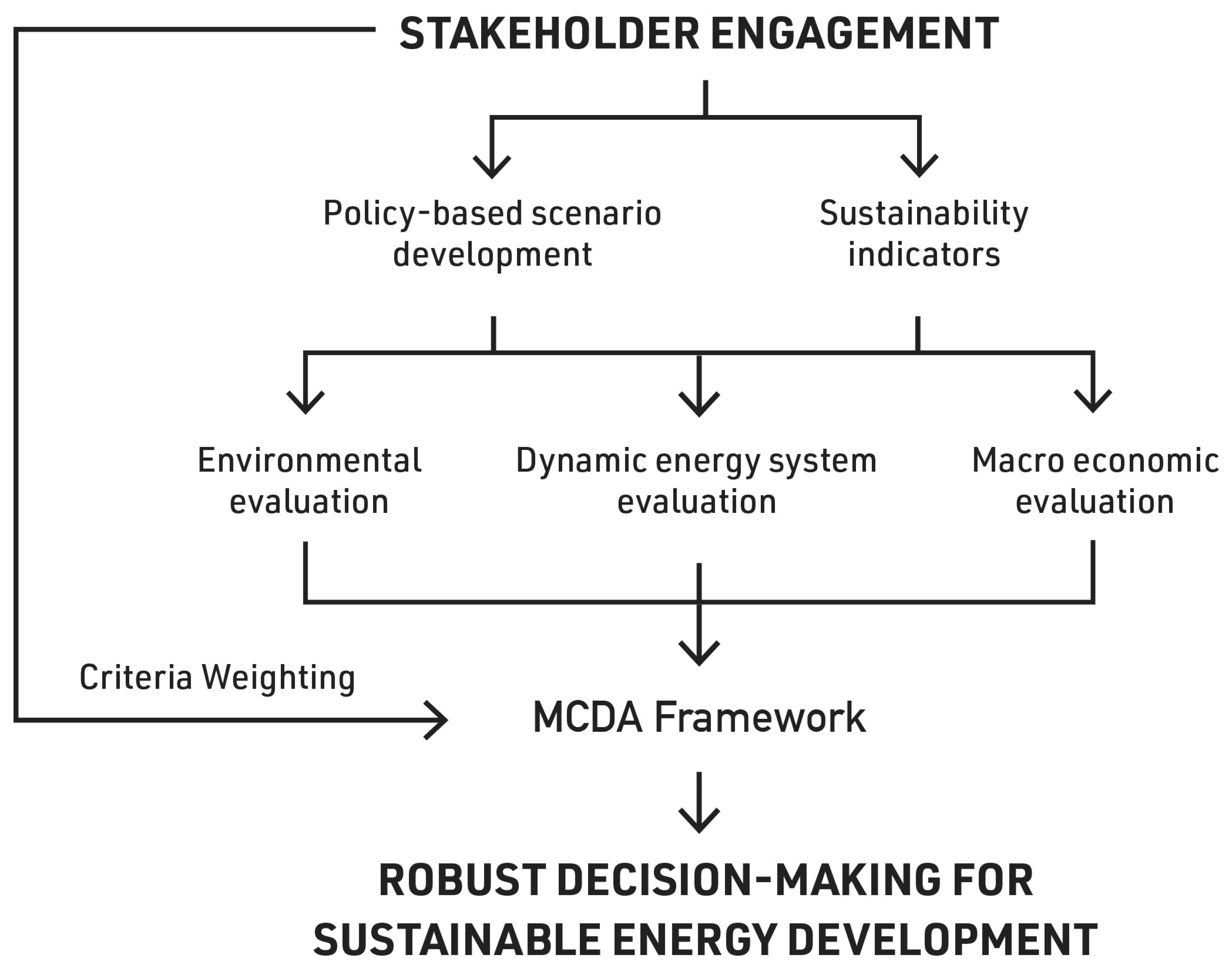
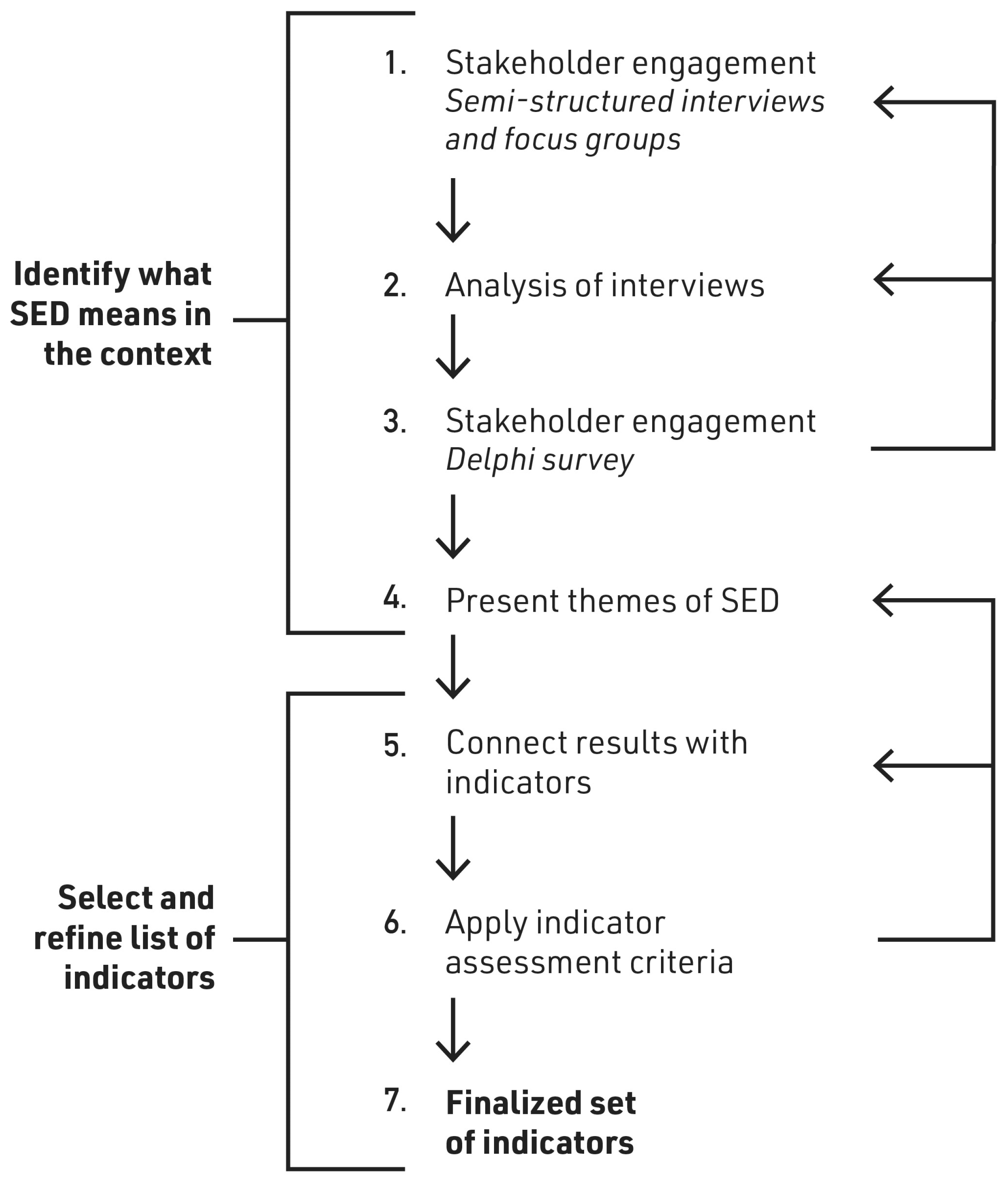
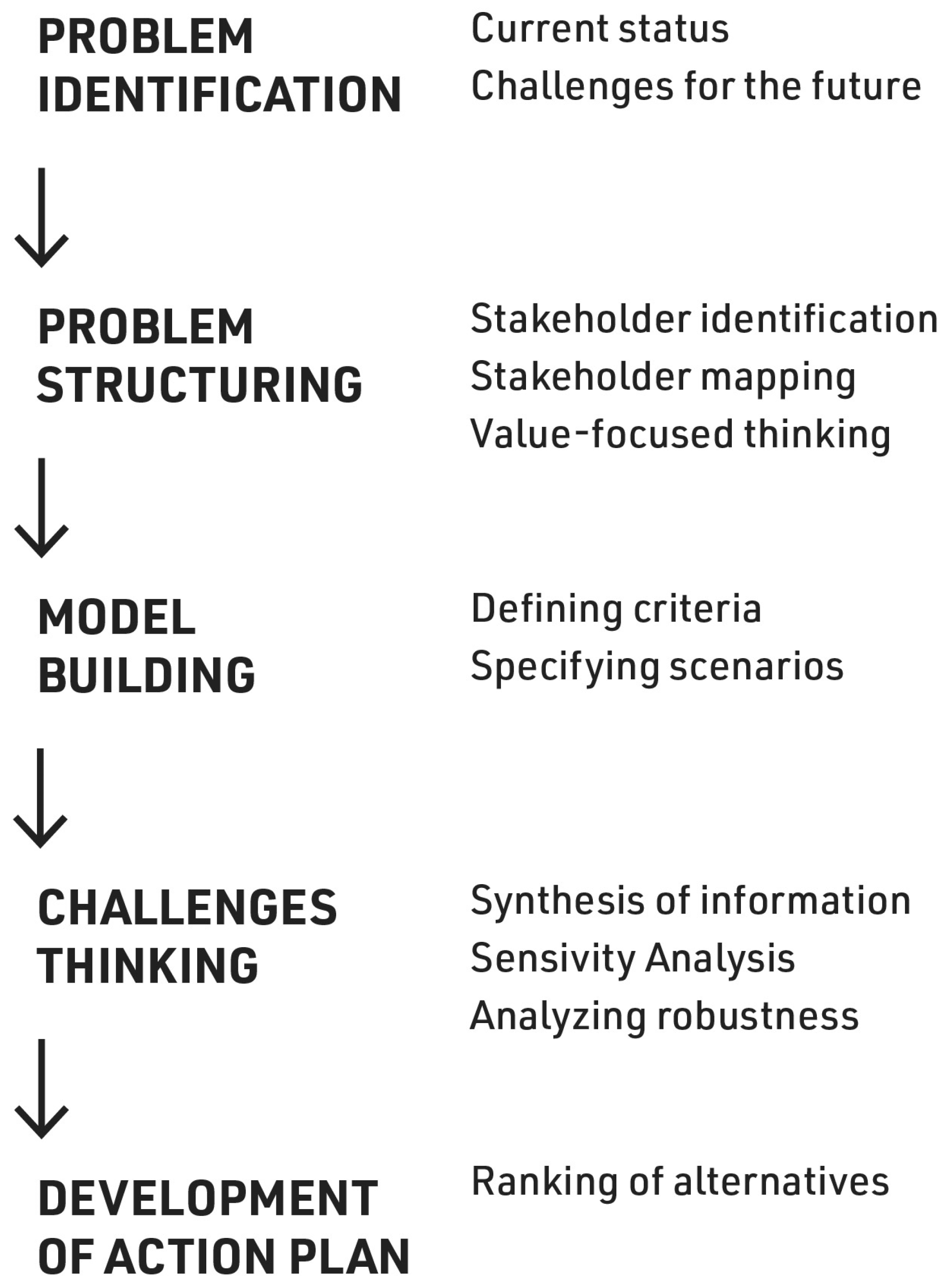
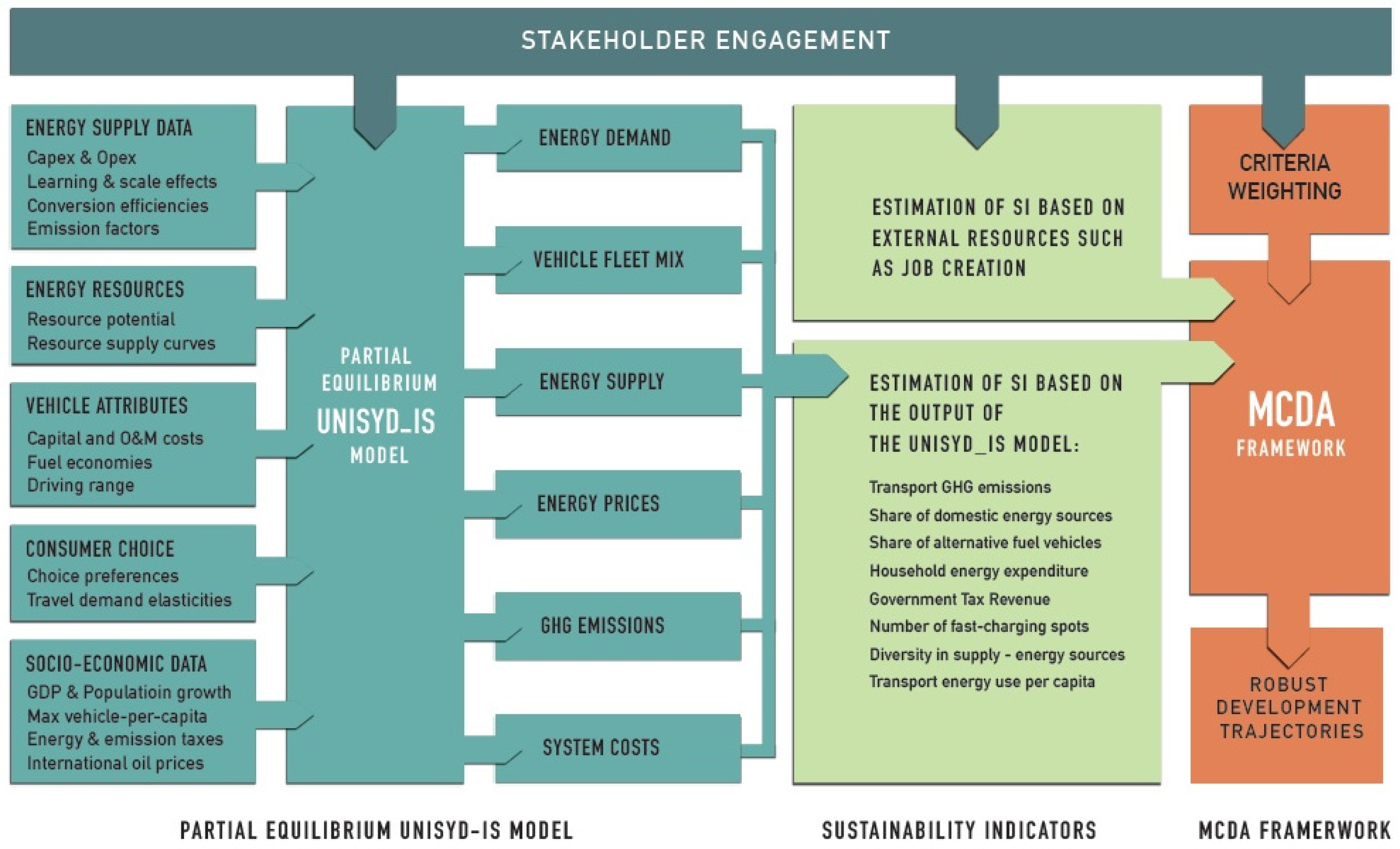

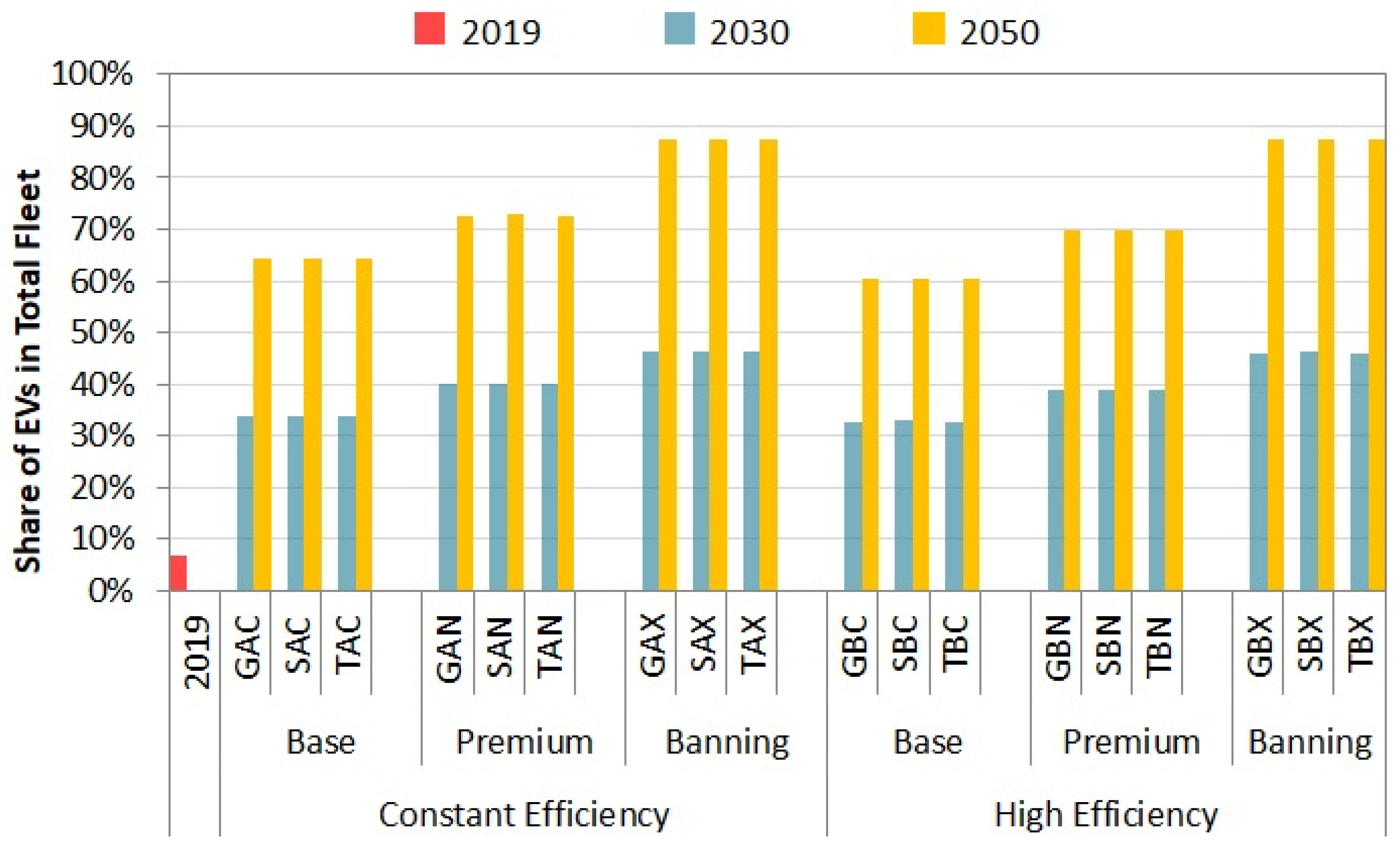


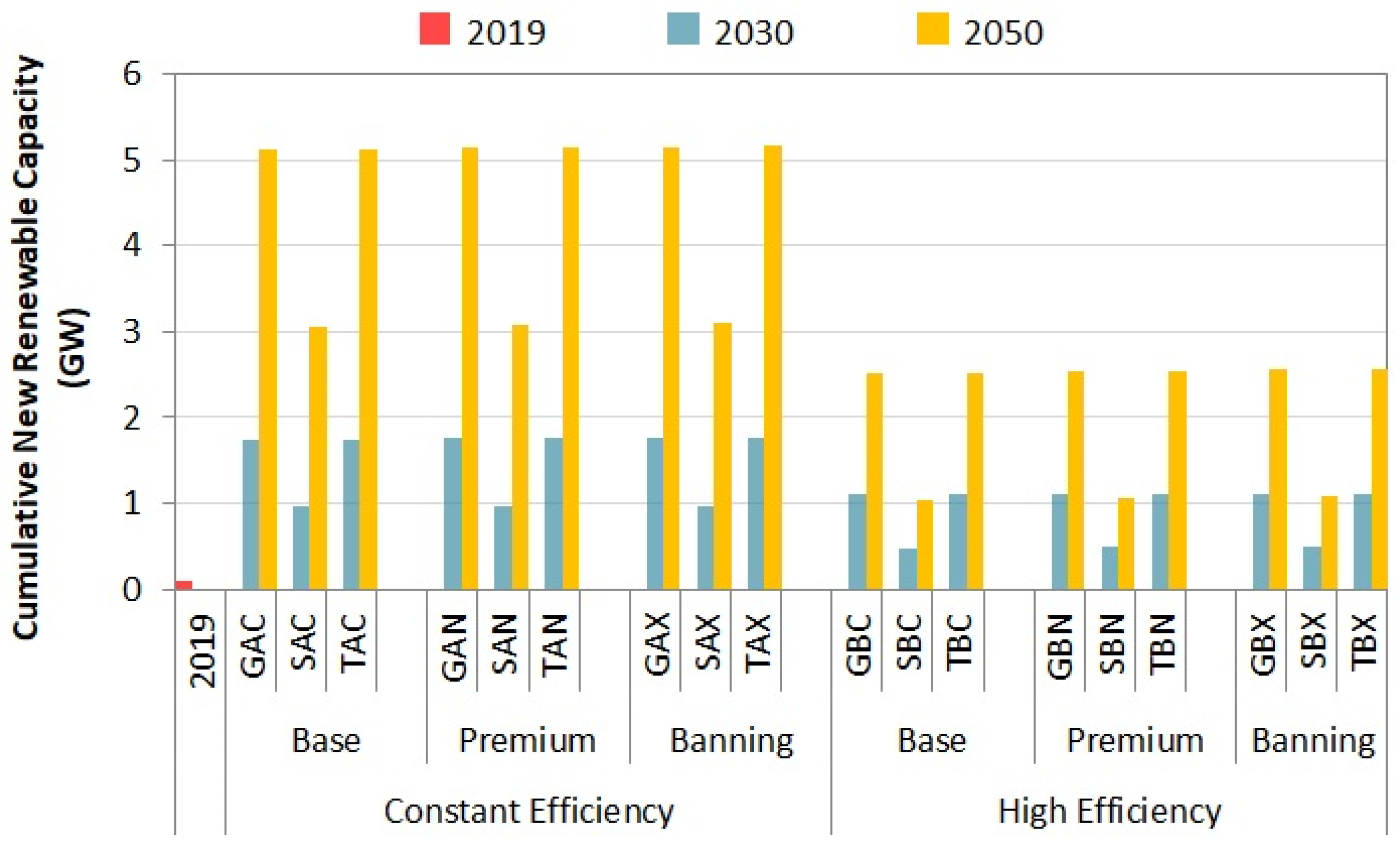


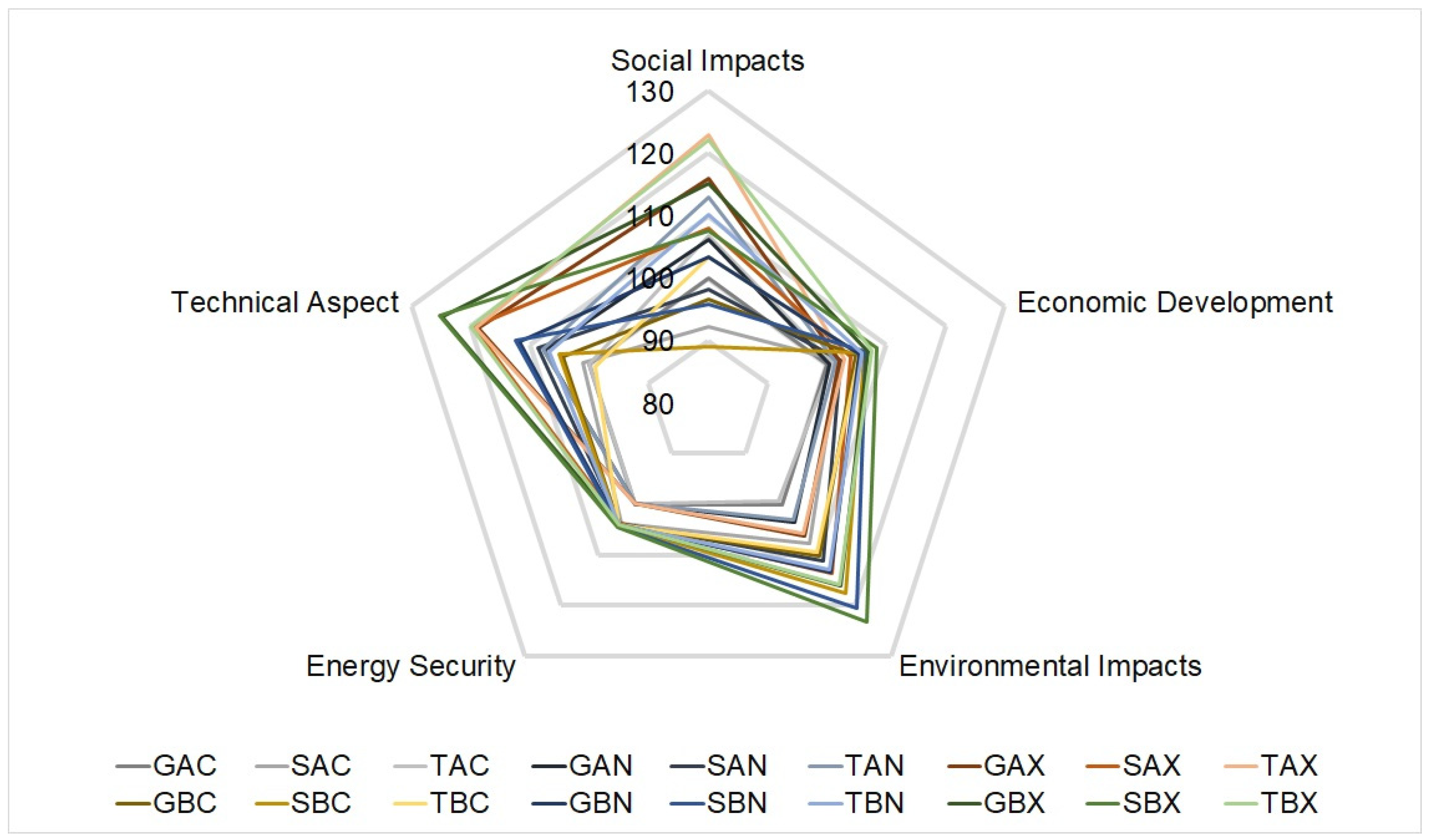




| Sustainability Theme | Sub-Theme | Indicators |
|---|---|---|
| Social Impacts | Social benefit | Total employment |
| Consumer behavior | The share of alternative fuel vehicles | |
| Economic Development | Government expenditure/revenue | Government tax revenue–expenditure (subsidies, investment, …) |
| Affordable energy price | Household expenditure on electricity and transport | |
| Economically efficient energy system | Energy intensity of the economy | |
| Environmental Impacts | Wilderness protection and visual pollution | Total impact area of power plants |
| Net emissions | GHG emissions from the transport sector | |
| Energy Security | Energy reserve | Dynamic reserve/production ratio |
| Diversity of energy sources | Diversity in energy supply | |
| Energy independence | Proportion of domestic energy sources in total primary energy supply | |
| Transition related technical aspects | Fuel switching | Share of alternative fuels in road transportation |
| Infrastructure Development | Total number of fast-charging spots and other eco-friendly multi-fuel stations | |
| Energy efficiency | Total final energy consumption in transportation per capita |
| Social Impacts | Economic Development | Environmental Impacts | Energy Security | Technical Aspect | |
|---|---|---|---|---|---|
| Industrial Users | 36% | 18% | 24% | 10% | 13% |
| Energy Producers | 13% | 24% | 18% | 36% | 10% |
| Decision Makers | 13% | 18% | 36% | 24% | 10% |
| Professional Interest Groups | 18% | 10% | 24% | 36% | 13% |
| Public | 13% | 18% | 36% | 24% | 10% |
| Distribution and transmission | 10% | 18% | 13% | 36% | 24% |
| NGOs | 36% | 18% | 24% | 13% | 10% |
| Average | 20% | 18% | 25% | 25% | 13% |
Disclaimer/Publisher’s Note: The statements, opinions and data contained in all publications are solely those of the individual author(s) and contributor(s) and not of MDPI and/or the editor(s). MDPI and/or the editor(s) disclaim responsibility for any injury to people or property resulting from any ideas, methods, instructions or products referred to in the content. |
© 2024 by the authors. Licensee MDPI, Basel, Switzerland. This article is an open access article distributed under the terms and conditions of the Creative Commons Attribution (CC BY) license (https://creativecommons.org/licenses/by/4.0/).
Share and Cite
Davidsdottir, B.; Ásgeirsson, E.I.; Fazeli, R.; Gunnarsdottir, I.; Leaver, J.; Shafiei, E.; Stefánsson, H. Integrated Energy Systems Modeling with Multi-Criteria Decision Analysis and Stakeholder Engagement for Identifying a Sustainable Energy Transition. Energies 2024, 17, 4266. https://doi.org/10.3390/en17174266
Davidsdottir B, Ásgeirsson EI, Fazeli R, Gunnarsdottir I, Leaver J, Shafiei E, Stefánsson H. Integrated Energy Systems Modeling with Multi-Criteria Decision Analysis and Stakeholder Engagement for Identifying a Sustainable Energy Transition. Energies. 2024; 17(17):4266. https://doi.org/10.3390/en17174266
Chicago/Turabian StyleDavidsdottir, Brynhildur, Eyjólfur Ingi Ásgeirsson, Reza Fazeli, Ingunn Gunnarsdottir, Jonathan Leaver, Ehsan Shafiei, and Hlynur Stefánsson. 2024. "Integrated Energy Systems Modeling with Multi-Criteria Decision Analysis and Stakeholder Engagement for Identifying a Sustainable Energy Transition" Energies 17, no. 17: 4266. https://doi.org/10.3390/en17174266
APA StyleDavidsdottir, B., Ásgeirsson, E. I., Fazeli, R., Gunnarsdottir, I., Leaver, J., Shafiei, E., & Stefánsson, H. (2024). Integrated Energy Systems Modeling with Multi-Criteria Decision Analysis and Stakeholder Engagement for Identifying a Sustainable Energy Transition. Energies, 17(17), 4266. https://doi.org/10.3390/en17174266








